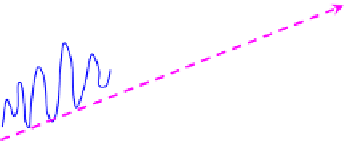Biomedical Engineering Reference
In-Depth Information
Continuing fossil use
Atmospheric CO
2
Biomass utilization
Undisturbed state
Standing biomass
Managed with utilization
Human Interruption
0
Time
FIGURE 15.13
Change of sustainable state owing to biomass utilization.
no human interruption at all. Nevertheless, there is a new sustainable state. This is also
reflected on the standing biomass. New sustainable states are foreseeable for biomass utiliza-
tion, whereas fossil utilization does not lead to a sustainable state. Therefore, despite the
changes caused by biomass utilization (true for all human interruptions), woody biomass
use is sustainable.
The effect of biomass harvesting and utilization on the CO
2
concentration in atmosphere
and storage depends not only on the standing biomass change (about 35% decrease for
optimum biomass yield as shown in Example 15-5) but also depends on the life span of
the harvested biomass and their derived products. If the harvested biomass was burnt for
energy, the life span is very short. The net effect of biomass utilization is the difference of total
biomass storage between a mature undisturbed forest and the managed forest should
a mature forest is converted to a biomass producing forest. For a mature undisturbed forest,
the total biomass storage is maximal at approximately the same as the carrying capacity, i.e.
X
SU
¼ X
N
(15.13)
where X
SU
is the total biomass storage for a mature undisturbed forest.
For a managed forest, the average standing biomass can be computed by
Z
t
H
X
av
¼
1
t
H
X
d
t
(15.14)
0
where X
av
is the average standing biomass, t
H
is the harvesting time or the time between har-
vestings. For harvesting occurring at exponential growth, when t
t
L
, X
¼
X
0
(lag phase) and
when t
L
t
t
H
, X
¼
X
0
exp[
m
G
(t
t
L
)] with
m
G
¼
constant. Eqn
(15.14)
can be integrated to
yield
t
L
t
H
þ
X
0
exp½m
G
ðt
H
t
L
Þ X
0
m
G
t
H
X
av
¼ X
0
(15.15)






















Search WWH ::

Custom Search